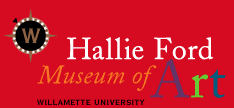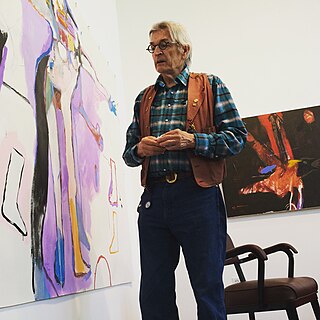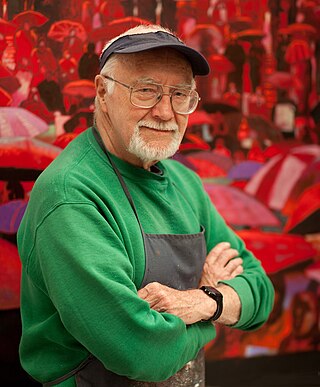Marie Watt is a contemporary artist living and working in Portland, Oregon. Enrolled in the Seneca Nation of Indians, Watt has created work primarily with textile arts and community collaboration centered on diverse Native American themes.

John Mix Stanley was an artist-explorer, an American painter of landscapes, and Native American portraits and tribal life. Born in the Finger Lakes region of New York, he started painting signs and portraits as a young man. In 1842 he traveled to the American West to paint Native American life. In 1846 he exhibited a gallery of 85 of his paintings in Cincinnati and Louisville. During the Mexican–American War, he joined Colonel Stephen Watts Kearney's expedition to California and painted accounts of the campaign, as well as aspects of the Oregon Territory.

The Hallie Ford Museum of Art (HFMA) is the museum of Willamette University in Salem, Oregon, United States. It is the third largest art museum in Oregon. Opened in 1998, the facility is across the street from the Oregon State Capital in downtown Salem, on the western edge of the school campus. Hallie Ford exhibits collections of both art and historical artifacts with a focus on Oregon related pieces of art and artists in the 27,000 square feet (2,500 m2) facility. The museum also hosts various traveling exhibits in two of its six galleries.

Charles Edward Heaney (1897–1981) was an American painter and printmaker. During the Great Depression in the 1930s, he worked for the Works Progress Administration as an artist and did several works featuring Mount Hood and Timberline Lodge as the subject matter.

Sally Haley was an American painter. Her career spanned much of the 20th century and she is credited for helping to expand the emerging art scene in Portland, Oregon, during the middle of the century. Much of her work was an application of egg tempera, a technique which leaves a flat, brushless surface. She preferred domestic subjects and interior spaces with hints of the indoor or outdoor space that lay beyond.

Hallie Brown Ford was an American business person and philanthropist. A native of Oklahoma, she acquired her wealth in Oregon through the timber industry. As a philanthropist she made donations to many institutions in Oklahoma and Oregon to support education and the arts. Shortly before her death in 2007, she made a donation of $15 million to the Pacific Northwest College of Art, the largest single donation to any cultural group in Oregon history.

Richard Elmer "Rick" Bartow was a Native American artist and a member of the Mad River band of the Wiyot Tribe, who are indigenous to Humboldt County, California. He primarily created pastel, graphite, and mixed media drawings, wood sculpture, acrylic paintings, drypoint etchings, monotypes, and a small number of ceramic works.
Gail Tremblay was an American writer and artist from Washington State. She is known for weaving baskets from film footage that depicts Native American people, such as Western movies and anthropological documentaries. She received a Washington State Governor's Arts and Heritage Award in 2001.
Laura Ross-Paul is a contemporary painter of oil and wax in the Pacific Northwest of the United States. In 2010 The Oregonian's OregonLive.com referred to her as a "venerable [figure] from Portland's long established vanguard" of art.

Phyllis Yes is an Oregon-based artist and playwright. Her artistic media range from works on painted canvas to furniture, clothing, and jewelry. She is known for her works that “feminize” objects usually associated with a stereotypically male domain, such as machine guns, hard hats, and hammers. Among her best-known artworks are “Paint Can with Brush,” which appears in Tools as Art, a book about the Hechinger Collection, published in 1996 and her epaulette jewelry, which applies “feminine” lace details to the epaulette, a shoulder adornment that traditionally symbolizes military prowess. In 1984 she produced her controversial and widely noted “Por She,” a silver 1967 Porsche 911-S, whose body she painstakingly painted in highly tactile pink and flesh-toned lace rosettes. She exhibited it at the Bernice Steinbaum Gallery in New York in 1984 and drove it across the United States as a traveling exhibition in 1985. In 2016, she wrote her first play, Good Morning Miss America, which began its first theatrical run at CoHo Theatre in Portland, Oregon in March 2018.

Wendy Red Star is an Apsáalooke contemporary multimedia artist born in Billings, Montana, in the United States. Her humorous approach and use of Native American images from traditional media draw the viewer into her work, while also confronting romanticized representations. She juxtaposes popular depictions of Native Americans with authentic cultural and gender identities. Her work has been described as "funny, brash, and surreal".

Constance Edith Fowler (1907–1996) was an American artist known as a painter and printmaker, an author, and an educator who taught at Willamette University and Albion College.
Norma Heyser is an American contemporary artist from Portland, Oregon, who worked in mixed media and new art forms, influenced by Cubism and Abstract expressionism.
Eunice Lulu Parsons, also known as Eunice Jensen Parsons, is an American modernist artist known for her collages. Parsons was born in Loma, Colorado, and currently lives in Portland, Oregon. She studied at the School of the Art Institute of Chicago and the Portland Museum Art School, where she also worked as a teacher for over 20 years.

Robert Henry Hess was an American sculptor and art educator. He was best known for his abstract metal sculptures and wood carvings. Hess served on the faculty of Willamette University in Salem, Oregon, for 34 years. Today, his works are found in prominent public spaces and private collections throughout the Pacific Northwest.
Nelle "Nel" Isabel Law (1914–1990) was an Australian artist, poet and diarist. As the wife of the scientist and explorer Phillip Law, she was the first Australian woman to set foot in Antarctica on 8 February 1961 when she travelled with her husband to the Mawson Station.

Michele Martin Taylor, is an American fine art painter. She is best known for her Post-Impressionist works in oil, watercolor and intaglio. Her subjects are often gardens, water and verdure, but also portraits, figural studies and interiors.

Ruth Dennis Grover (1912–2003) was a painter and educator from Oregon known for her landscapes and her abstract art.

K.A. Colorado, is an American-Canadian visual artist, painter, and sculptor best known for his representational work depicting climate change, deep cold, and the environment. He was the artist-in-residence for the National Oceanic and Atmospheric Administration, and is the creator of the Ice Core Sculpture Series depicting polar scientific studies, material, and DNA from around the world.

George Johanson was a painter, printmaker, and ceramic tile artist. Johanson studied at the Museum Art School in Portland, Oregon, with further study in New York as well as London. He taught at the Museum Art School for 25 years until his retirement from teaching in 1980.














